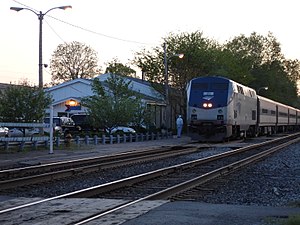Blue Water (train)
 An Amtrak Blue Water train pulling into the East Lansing station. | ||||||||||||||||||||||||||||||||||||||||||||||||||||||||||||||||||||||||||||||||||||||||||||||||||||||||||||||||||||||||||||||||||||||||||||||||||||||||||||
| Overview | ||||||||||||||||||||||||||||||||||||||||||||||||||||||||||||||||||||||||||||||||||||||||||||||||||||||||||||||||||||||||||||||||||||||||||||||||||||||||||||
|---|---|---|---|---|---|---|---|---|---|---|---|---|---|---|---|---|---|---|---|---|---|---|---|---|---|---|---|---|---|---|---|---|---|---|---|---|---|---|---|---|---|---|---|---|---|---|---|---|---|---|---|---|---|---|---|---|---|---|---|---|---|---|---|---|---|---|---|---|---|---|---|---|---|---|---|---|---|---|---|---|---|---|---|---|---|---|---|---|---|---|---|---|---|---|---|---|---|---|---|---|---|---|---|---|---|---|---|---|---|---|---|---|---|---|---|---|---|---|---|---|---|---|---|---|---|---|---|---|---|---|---|---|---|---|---|---|---|---|---|---|---|---|---|---|---|---|---|---|---|---|---|---|---|---|---|---|
| Service type | Inter-city rail, higher-speed rail | |||||||||||||||||||||||||||||||||||||||||||||||||||||||||||||||||||||||||||||||||||||||||||||||||||||||||||||||||||||||||||||||||||||||||||||||||||||||||||
| Locale | Michigan | |||||||||||||||||||||||||||||||||||||||||||||||||||||||||||||||||||||||||||||||||||||||||||||||||||||||||||||||||||||||||||||||||||||||||||||||||||||||||||
| Predecessor | International | |||||||||||||||||||||||||||||||||||||||||||||||||||||||||||||||||||||||||||||||||||||||||||||||||||||||||||||||||||||||||||||||||||||||||||||||||||||||||||
| First service | April 25, 2004 | |||||||||||||||||||||||||||||||||||||||||||||||||||||||||||||||||||||||||||||||||||||||||||||||||||||||||||||||||||||||||||||||||||||||||||||||||||||||||||
| Current operator(s) | Amtrak | |||||||||||||||||||||||||||||||||||||||||||||||||||||||||||||||||||||||||||||||||||||||||||||||||||||||||||||||||||||||||||||||||||||||||||||||||||||||||||
| Ridership | 191,106 (FY13)[1] | |||||||||||||||||||||||||||||||||||||||||||||||||||||||||||||||||||||||||||||||||||||||||||||||||||||||||||||||||||||||||||||||||||||||||||||||||||||||||||
| Route | ||||||||||||||||||||||||||||||||||||||||||||||||||||||||||||||||||||||||||||||||||||||||||||||||||||||||||||||||||||||||||||||||||||||||||||||||||||||||||||
| Termini | Chicago, Illinois Port Huron, Michigan | |||||||||||||||||||||||||||||||||||||||||||||||||||||||||||||||||||||||||||||||||||||||||||||||||||||||||||||||||||||||||||||||||||||||||||||||||||||||||||
| Distance travelled | 319 miles (513 km) | |||||||||||||||||||||||||||||||||||||||||||||||||||||||||||||||||||||||||||||||||||||||||||||||||||||||||||||||||||||||||||||||||||||||||||||||||||||||||||
| Service frequency | Daily | |||||||||||||||||||||||||||||||||||||||||||||||||||||||||||||||||||||||||||||||||||||||||||||||||||||||||||||||||||||||||||||||||||||||||||||||||||||||||||
| Train number(s) | 364, 365 | |||||||||||||||||||||||||||||||||||||||||||||||||||||||||||||||||||||||||||||||||||||||||||||||||||||||||||||||||||||||||||||||||||||||||||||||||||||||||||
| Technical | ||||||||||||||||||||||||||||||||||||||||||||||||||||||||||||||||||||||||||||||||||||||||||||||||||||||||||||||||||||||||||||||||||||||||||||||||||||||||||||
| Track gauge | 4 ft 8+1⁄2 in (1,435 mm) | |||||||||||||||||||||||||||||||||||||||||||||||||||||||||||||||||||||||||||||||||||||||||||||||||||||||||||||||||||||||||||||||||||||||||||||||||||||||||||
| Track owner(s) | CN/GTW, Amtrak, MDOT NS | |||||||||||||||||||||||||||||||||||||||||||||||||||||||||||||||||||||||||||||||||||||||||||||||||||||||||||||||||||||||||||||||||||||||||||||||||||||||||||
| ||||||||||||||||||||||||||||||||||||||||||||||||||||||||||||||||||||||||||||||||||||||||||||||||||||||||||||||||||||||||||||||||||||||||||||||||||||||||||||
| Overview | |
|---|---|
| Service type | Inter-city rail |
| Locale | Michigan |
| First service | September 15, 1974 |
| Last service | October 31, 1982 |
| Successor | International Limited |
| Former operator(s) | Amtrak |
| Route | |
| Termini | Chicago, Illinois Port Huron, Michigan |
| Distance travelled | 319 miles (513 km) |
| Service frequency | Daily |
| Train number(s) | 364, 365 |
The Blue Water is a higher-speed passenger train service operated by Amtrak as part of its Michigan Services. The 319-mile (513 km) line connects Port Huron, Michigan, and Chicago, Illinois, via East Lansing, Michigan.
History
The Lansing area, home of the Michigan state capitol and Michigan State University, was left out of Amtrak's original system. Beginning in 1973, Amtrak and the state discussed restoring service over the Grand Trunk Western Railway within the state, although the new route would join Amtrak's other Michigan trains on the Penn Central west of Battle Creek, Michigan, eschewing the Grand Trunk's traditional route to Chicago. New stations were built in Port Huron and East Lansing, and the state spent $1 million on track rehabilitation. Service began September 15, 1974, between Chicago and Port Huron, with the intention of eventually restoring the Port Huron–Toronto leg.[2]: 204–204
Amtrak renamed the train the Blue Water Limited on October 26, 1975, and re-equipped it with French-built Turboliner trainsets on May 20, 1976. The new Turboliners were capable of, but never reached, 125 mph (201 km/h) and ran with fixed five-car consists with an overall capacity of 292 passengers. The Turboliners were withdrawn on October 25, 1981, replaced by conventional locomotives pulling Amfleet coaches.[2]: 204, 208
International
The long-discussed extension to Toronto finally occurred on October 31, 1982. The extended service received the name International Limited, the name of an old Canadian National/Grand Trunk Chicago–Detroit–Montreal train. Amtrak and Via Rail, the state-supported Canadian rail company, jointly operated the International Limited (later just International) until April 25, 2004, when cross-border service was discontinued. Massive border delays post-September 11 led to falling ridership; Amtrak and Michigan agreed to truncate service at Port Huron and bring back the old Blue Water.[2]: 207 On the Canadian side service ends at Sarnia as part of the VIA Rail's Corridor route.
Current
With a more favorable intrastate schedule and fewer delays, the Blue Water's ridership showed immediate improvements, carrying 94,378 passengers in fiscal year 2004 (compared to 80,890 in FY 2003).[2]: 208 Blue Water ridership in FY 2011 totaled 187,065, an increase of 18.0 percent from FY 2010's total of 157,709, and the highest total ever recorded by the train.[3] During FY 2011, the train had a total revenue of $5.8 million, a 22.3 percent increase from FY 2010's total of $4.7 million.[3]
Route details
The Blue Water operates over Norfolk Southern Railway, Amtrak, and Grand Trunk Western Railroad trackage:
- NS Chicago Line, Chicago to Porter, Indiana
- Amtrak Chicago–Detroit Line, Porter, Indiana, to Kalamazoo, Michigan
- MDOT Michigan Line, Kalamazoo, Michigan, to Battle Creek, Michigan [4]
- CN/GTW Flint Subdivision, Battle Creek, Michigan, to Port Huron, Michigan

Station stops
High-speed rail
The Detroit–Chicago corridor has been designated by the Federal Railroad Administration as a high-speed rail corridor.[5] A 97-mile (156 km) stretch along the route of Blue Water from Porter, Indiana to Kalamazoo, Michigan is the longest segment of track owned by Amtrak outside of the Northeast Corridor.[5] Amtrak began speed increases along this stretch in January 2002. Ultimately, speed increased to 110 mph (180 km/h).[5][6]
Cultural references
The Blue Water Line was featured in a song by that name written by Dora Graf and Martin Seligson and popularized by The Brothers Four.[7]
Consist
Today, a normal Amtrak Blue Water consists of:[8]
- One GE Genesis P40DC or P42DC locomotive
- One non-powered cab car, rebuilt from an EMD F40PH
- Five or Six Horizon Fleet or Amfleet I coaches
- One or Two Horizon Fleet or Amfleet I cafe/business cars
References
- ^ "Annual Ridership Summary". MDOT Rail Statistics. MDOT. Retrieved October 17, 2013.
- ^ a b c d Sanders, Craig (2006). Amtrak in the Heartland. Bloomington, Indiana: Indiana University Press. ISBN 978-0-253-34705-3.
- ^ a b "Amtrak reports record Michigan ridership". The Grand Rapids Press. October 14, 2011. Retrieved October 16, 2011.
- ^ Kalamazoo Gazette file photo (October 11, 2011). "Details emerging on MDOT purchase of train track from Kalamazoo to Dearborn". MLive. Booth Newspapers. Retrieved January 26, 2014.
- ^ a b c "Amtrak Fact Sheet, Fiscal Year 2005" (PDF). Amtrak. Retrieved October 30, 2006.
- ^ "Michigan: Amtrak taking service to new speeds". WNDU-TV. Retrieved November 1, 2006. [dead link]
- ^ "The Brothers Four Greatest Hits". Google Music. Retrieved October 25, 2008.
- ^ "Blue Water". TrainWeb. Retrieved October 22, 2010.
